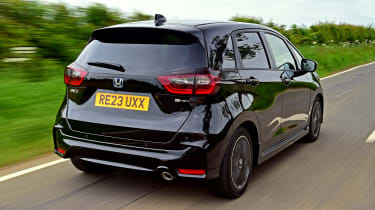Honda Jazz review: a sensible supermini, but it’s more costly than rivals
Practical, efficient and highly specced, the hybrid Honda Jazz supermini is an attractive if relatively pricey package

Quick verdict:
The fourth-generation Honda Jazz aims to attract buyers interested in better fuel economy, up-to-date connectivity, and reasonable running costs. Does it succeed? For the most part, yes – and it should hold its value well, too.
On the downside, the Jazz is still a boxy, uninspiring shape and lacks the fun factor other rivals offer. Its infotainment system isn’t the best in this highly competitive class, either. However, the Japanese supermini’s hybrid powertrain is impressive, and if you prioritise practicality over style, it could be the right choice. Just remember to drive a hard bargain at the dealership on those high list prices.
Honda Jazz: price, specs and rivals
The Honda Jazz has been around since 2002 in the UK, and over the intervening years, its mix of practicality, reliability and low running costs has won a loyal band of repeat customers.
But the Jazz’s unassuming nature has made it hard to reach customers outside that loyal band of buyers who have homed in on the little Honda’s common-sense qualities.
The latest model introduced in 2020 is the fourth generation, and whereas in Japan it’s available with 1.3-litre petrol or 1.5-litre hybrid power, here in the UK, it’s the hybrid e:HEV variant that’s the only option. That decision is in line with Honda’s stated intention to eliminate conventional powertrains from its European line-up – something it has nearly achieved, with the Civic Type-R the sole petrol-only model in the Honda range.
Used - available now
Only offering hybrid power is similar to that of its rival, the Toyota Yaris. Like the Yaris, the Jazz allows for brief periods of electric-only driving – up to a mile, in fact. While that sounds insignificant, it really helps in stop/start city driving to save fuel.
While clever hybrid tech has environmental benefits, the Jazz still has its work cut out to catch the attention of supermini buyers who want to drive something a little more fun or funky. The Jazz’s roster of rivals is impressively long, including big names such as the Renault Clio, Vauxhall Corsa, and Volkswagen Polo. There’s also the Polo’s fellow stablemates, the SEAT Ibiza and Skoda Fabia to consider, along with the likes of the Hyundai i20, Mazda 2 Hybrid, and Peugeot 208.
The latest Jazz comes to the fight with strong equipment levels across four model grades: Elegance, Advance, Advance Sport, and the SUV-inspired Crosstar Advance version. All versions come with plenty of equipment, getting 15-inch alloy wheels, a nine-inch central touchscreen with Apple CarPlay and Android Auto, climate control, front and rear parking sensors, and a reversing camera.
The mid-range Advance gets sat-nav, heated front seats and steering wheel, privacy glass and larger 16-inch alloy wheels. The Advance Sport adds to this with sport-inspired details to its body styling, a special exhaust finisher, ultrasuede interior trim, sports pedals, a three-spoke steering wheel, and a Sport drive mode – though the powertrain remains the same.
Honda introduced the Jazz Crosstar model in mid-2020 to sit alongside the regular five-door hatchback. It has a raised ride height, body cladding, and roof rails for a pseudo-4x4 look – just don’t expect any off-road ability because it lacks four-wheel drive. Based on the Advance-spec Jazz, it’s more expensive than the regular car and slightly less efficient. In our opinion, it’s out of step with the overall ethos of the Jazz, so we’d suggest you stick with the mid-range Advance trim instead.













